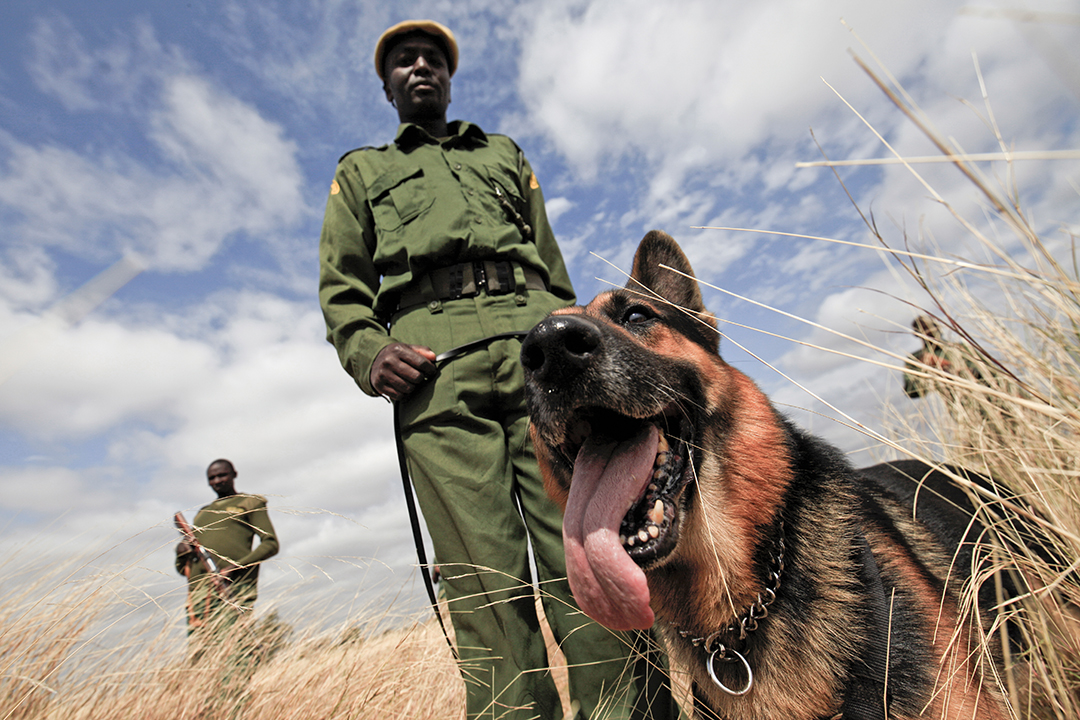Stopping the slaughter requires a commitment from communities.
ADF STAFF | photos by FELIPE RODRIGUEZ
In April 2016, Kenyan officials built 11 massive piles of confiscated ivory and rhino horn in Nairobi National Park and set them on fire. The piles represented 6,500 slain elephants and 450 rhinos.
The 105 tons of ivory and 1.35 tons of rhino horn were worth an estimated $150 million, National Geographic writer Rachel Nuwer reported.
And it was only a fraction — about 5 percent — of the ivory and horns stockpiled by African governments. Animal poaching is big business.

Africa has about 400,000 remaining elephants, with 1 in 5 slaughtered in the past decade for its tusks, according to March 2016 statistics. In 2015, 1,338 rhinos were killed for their horns. The rhino population now stands at fewer than 26,000.
The sheer size of the continent, and the vast stretches of land the creatures need to graze, makes anti-poaching patrols daunting and expensive. Experts say that the only way to prevent poaching is to get more than just traditional government forces involved.
Government officials are divided on the policy of burning ivory and rhino horns. They note that the ivory and horns are worth millions and that selling the confiscated material could, in theory, lessen demand and reduce poaching.
“There’s a passing of judgment from some that we’re doing the wrong thing, because Kenya is a poor country, and we could use the $150-million-odd dollars that they claim the ivory is worth to develop our nation,” Kenyan President Uhuru Kenyatta told National Geographic at the time of the burning. “But I would rather wait for the judgment of future generations, who I am sure will appreciate the decision we have taken today.”
This is not the first time Africa has faced the wholesale slaughter of its elephants. In the 1970s, demand for ivory soared worldwide. The next two decades saw Africa’s elephant population reduced by half. In 1989, the Convention on International Trade in Endangered Species of Wild Fauna and Flora banned all international ivory sales. But in 1999 and 2008, four African countries permitted limited ivory sales in Asia. Instead of satisfying demand for the ivory, the limited sales had the reverse effect: Demand and prices soared, and poaching increased dramatically.
Kenya and other countries now believe that the only way to stop poaching is to shame the market into rejecting ivory and rhino horn. They contend that the world should regard ivory and rhino horn as nothing more than parts of animal carcasses.
NEW METHODS ARE NEEDED
One thing is clear: The poachers will not be stopped using wildlife patrols alone. New ideas, new players and new intelligence are needed. Nongovernmental organizations (NGOs), particularly conservation groups including Honeyguide Foundation, the Friedkin Conservation Fund and Conservation International, are getting involved.
In Tanzania alone, the list of key stakeholders in preventing poaching includes the Tanzanian National Parks Association, the Tanzania People’s Defence Force, the Tanzania Police Force, Interpol, international NGOs, local NGOs and community conservation groups.
These groups also have recognized the need to work together regionally. In 2013, the Southern African Development Community developed a plan to stop poaching:

Improve communication among law enforcement at local, national, regional and international levels.
Improve capacities of law enforcement, customs and immigration agencies to detect and stop illegal wildlife trade.
Increase dialogue among local stakeholders.
Establish a regional monitoring center to look for signs of poaching and related commerce.
Jeremy Swanson, a conservation and development consultant based in Tanzania, has worked regularly in East Africa for nearly 15 years. Swanson told ADF the poachers have to be treated as more than just some villagers out to make some quick money.
“They have money available,” he said. “Big money. They are highly militarized groups, and they are heavily armed. They shot down a helicopter on one anti-poaching patrol.”
 The extent of the danger in tracking poachers can be seen in an April 23, 2016, attack in the Democratic Republic of the Congo’s Garamba National Park. Elephant poachers killed three rangers and wounded two other people.
The extent of the danger in tracking poachers can be seen in an April 23, 2016, attack in the Democratic Republic of the Congo’s Garamba National Park. Elephant poachers killed three rangers and wounded two other people.
“Rangers put their lives on the line each and every day, and are under real siege in Garamba, protecting elephants from heavily incentivized and militarized poaching gangs,” Peter Fearnhead, chief executive of conservation group African Parks, told Voice of America.
These days, rangers tracking poachers have a new tool: highly trained dogs. The Big Life Foundation began using dogs to track poachers in 2011, with help from Canine Specialist Services International, a facility based in northern Tanzania. Alsatians, a type of German shepherd, are now used because of their stamina and resistance to heat. They have become so useful that many branches of the Tanzanian government have asked to use the dogs.
“Apart from their incredible tracking abilities, dogs are wonderful to work with because they don’t have any political agenda — they can’t be compromised,” said Damien Bell, director of Big Life Tanzania, the conservation organization that manages the Big Life Tracker Dog Unit. “Our dogs have tracked elephant poachers for up to eight hours at a time or more, through extreme conditions — heat, rain, wetlands, mountains — and still turned up results.”
LOCAL INVOLVEMENT
Swanson said local buy-in is critical in finding poachers.
“We’re seeing some positive signs, both in Kenya and Tanzania,” he said. “We’ve seen significant decreases in elephant poaching and some key arrests made over the past year. We’re seeing a pretty rapid increase in sentencing, even for some higher-level, midlevel kind of traffickers.”
Historically, the prosecution of poachers has been a problem. Often, after poachers are in custody, they are released on cash bonds, often in the tens of thousands of dollars. Later, the charges may be dropped because of “lost files.”

The files may be genuinely lost because of bureaucratic bungling. Or, as National Geographic reported in December 2015, they may be “backroom loopholes,” deliberately disappearing due to government corruption. NGO WildlifeDirect reports that in Kenya, only 10 percent of the poachers arrested are actually prosecuted. About one-fourth of the cases are dismissed by magistrates or withdrawn by the prosecution due to a lack of evidence.
Tanzanian President John Pombe Magufuli, elected in late 2015, wondered how the ivory was getting out of the country in the first place. He noted that tusks were being confiscated in China and Europe after successfully getting out of the port of Dar es Salaam.
Aside from the usual government forces, Swanson said, “some people have not seen what communities can do to stop the poachers.” The role, he said, can be a “very, very big one and an important one, especially when it comes to intelligence.”
There’s a lot at stake. African nations are aware of the incredible amount of tourism money at risk if the animals become scarce.
“Everyone in a community, including women, youth and the elderly, has a role to play to ensure long-term sustainability of their communities and wildlife close to protected areas,” Helen Clark of the United Nations told The Guardian of London in 2014. “Community-based initiatives must be supported to generate income for rural people and help diversify incomes through tourism and other service sectors.”
These initiatives, said Swanson, are not optional.
“If you don’t get the community buy-in, these villages that are around the national parks, around the game preserves, you’re really fighting an uphill battle,” he said. That buy-in has to include the gathering of local intelligence. Rewards programs have become a critical part of that information gathering.
 “A major part of the success of some of these smaller organizations are the incentives,” Swanson said. “There are incentives for data collection; we all need data. There are incentives for confiscation of weapons, confiscation of ivory and other trophies, arrests that lead to prosecution. It’s a major, major part of how to get local teams mobilized.
“A major part of the success of some of these smaller organizations are the incentives,” Swanson said. “There are incentives for data collection; we all need data. There are incentives for confiscation of weapons, confiscation of ivory and other trophies, arrests that lead to prosecution. It’s a major, major part of how to get local teams mobilized.
“I’ve been in situations where we go into a place with local scouts, and several of the scouts have been suspected of actual poaching,” Swanson said. “You have an issue where they weren’t receiving adequate salaries or completely neglected for months at a time, and they didn’t have any kind of actual incentive to do their jobs. A group I was working with for a while was able to get in there, weed out some of the bad characters, and even reform some of the guys there who might have been involved and provide them incentives. We’ve been able to make poaching negligible in some areas.”
In a study published in 2014 in Conservation Letters, an online scientific journal, authors Dan Challender and Douglas MacMillan said law enforcement and regulations will not be enough to stop poachers.
“In the immediate future, we should incentivize and build capacity within local communities to conserve wildlife,” they wrote. “Current enforcement methods are proving unsuccessful and more needs to be done to bring local communities, which live in … proximity to the species, on board by rewarding them for conserving wildlife.”

